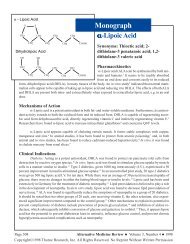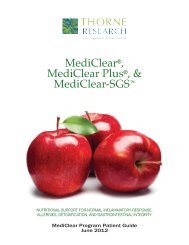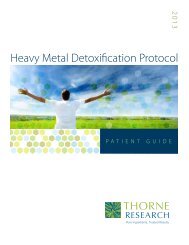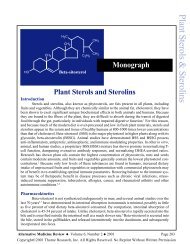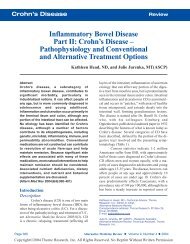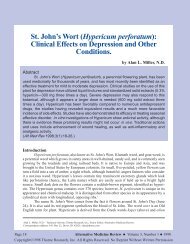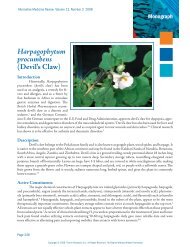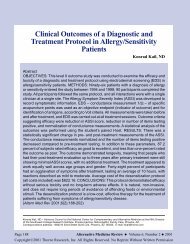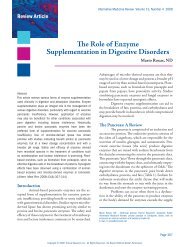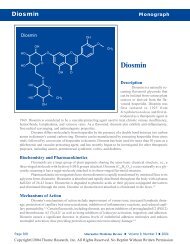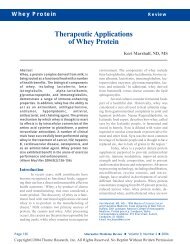Panax Ginseng - Thorne Research
Panax Ginseng - Thorne Research
Panax Ginseng - Thorne Research
You also want an ePaper? Increase the reach of your titles
YUMPU automatically turns print PDFs into web optimized ePapers that Google loves.
Review<strong>Panax</strong> ginseng and Cancerreduced dysplastic crypts, although initiationphase inhibition was weak, limiting a prophylacticeffect. 81,82Gastric CancerRed ginseng was found effective in patientswith stage III gastric cancer for improvingboth post-operative immunity and survival. IncreasedCD3 and CD4 activity was reported witha five-year survival for P. ginseng patients markedlyhigher than control (68.2% versus 33.3%).Reported dose was 4.5 g/day for the first sixmonths after surgery. 83 Inhibitory effects have alsobeen found in cell-line cultures. 84-86Hepatic CancerRed ginseng (3.78 g/kg/wk) was shownto act as a highly significant preventative to inducedliver cancer. In a rat study, when taken for15 weeks prior to diethylnitrosamine exposure,only 14.3 percent of the rats had liver morphologicalchanges indicative of cancer, while thecontrol group tallied 100-percent induction. P. ginsengacts to decrease the speed of tumor developmentand protect the ultrastructure of hepatocytes.87 P. ginseng metabolites (Rg3, Rg5, Rk1,Rs5, and Rs4) have a 50-percent growth inhibitionconcentration in hepatoma cells – significantlylower than cisplatin (CDDP). 88 Other positive studiesfrom 1978-2004 are noted with hepatoma celllines. 19,20,45,48,49,51,55,57Kidney CancerThe proliferation of renal cell carcinomais reduced with red ginseng via a decrease in c-fos and c-jun gene expression. Only partial inhibitionwas produced with use of -diol or -triol fractionsindependently. 89LeukemiaIn the human promyelocytic leukemiacells (HL-60) P. ginseng (fresh steamed) has beenshown to scavenge ROS 44 and Compound K toinduce apoptosis and inhibit proliferation. 50MelanomaIn mice, ginseng extracts and ginsenosidesboth significantly inhibited lung metastasis frommelanoma. 90 Cell-line studies have shown controlof differentiation (by Rh1 and Rh2), 21,22 inhibitionof proliferation (by red ginseng), 8 inhibition oftumor angiogenesis and metastasis (by Rb2), 61 andmost recently proliferation inhibition via up-regulationof p27 and down-regulation of c-Muc andcyclin D1 (by Compound K). 56Ovarian CancerRh2 was found to inhibit ovarian tumorgrowth in mice by induction of apoptosis and increasedNK-cell activity. Oral, but not intraperitoneal,treatment was found effective. The doseof 0.4-1.6 mg/kg was significant when given daily,but not weekly. The antitumor activity was similarto 4 mg/kg of CDDP, while also expressing asignificant increase in survival. 91Prostate CancerRg3 has displayed growth inhibitory activityas well as reduced biomarkers for prostatecancer (notably prostate specific antigen, androgenreceptors, and 5 alpha-reductase). This studysuggests induction of apoptosis through caspase-3 with the activated expression of cyclin-kinaseinhibitors, p21 and p27. 92Pulmonary CancerCompound K has been shown to treatCDDP-resistant pulmonary cancer, with only a20.3 microM concentration needed to inhibit cellproliferation by 50 percent (CDDP 60.8microM). 86 Ginsenosides have shown significanteffect in induced lung cancers. 24-26,65,93,94 A polysaccharidefraction has also shown dose-dependentinhibition in mouse lung tumor incidence. 72Other Cancer-related UsesUltraviolet Radiation ProtectionPrepared under high heat, red ginsengextract has protected DNA from UV-induced fragmentation– the heralding of apoptosis. 44 P. ginsenghas also been shown to protect different cellAlternative Medicine Review ◆ Volume 9, Number 3 ◆ 2004 Page 267Copyright©2004 <strong>Thorne</strong> <strong>Research</strong>, Inc. All Rights Reserved. No Reprint Without Written Permission



